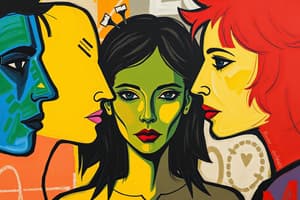Podcast
Questions and Answers
What is the effect of labeling according to labeling theories?
What is the effect of labeling according to labeling theories?
- It is always negative.
- It can cause crime continuation and escalation. (correct)
- It has no effect on deviance.
- It only applies to certain individuals.
Labeling theories suggest that the actual deviance is more important than who applies the labels.
Labeling theories suggest that the actual deviance is more important than who applies the labels.
False (B)
Who is a prominent figure associated with labeling theories?
Who is a prominent figure associated with labeling theories?
Howard S. Becker
According to Howard S. Becker, behavior is defined as 'wrong' based on the application of __________.
According to Howard S. Becker, behavior is defined as 'wrong' based on the application of __________.
Match the following key concepts with their descriptions:
Match the following key concepts with their descriptions:
According to Becker's labeling approach, deviance is primarily defined by which of the following?
According to Becker's labeling approach, deviance is primarily defined by which of the following?
Labeling someone as a deviant can positively affect their self-image.
Labeling someone as a deviant can positively affect their self-image.
What role do social interactions play in the concept of identity according to symbolic interactionism?
What role do social interactions play in the concept of identity according to symbolic interactionism?
In Becker's labeling theory, a 'deviant' is defined as someone to whom the label has successfully been _____ applied.
In Becker's labeling theory, a 'deviant' is defined as someone to whom the label has successfully been _____ applied.
Match the following theorists with their contributions to symbolic interactionism:
Match the following theorists with their contributions to symbolic interactionism:
What is the first step in the deviance and labeling sequence according to Lemert?
What is the first step in the deviance and labeling sequence according to Lemert?
Stronger penalties and rejection occur after the community stigmatizes the deviant.
Stronger penalties and rejection occur after the community stigmatizes the deviant.
What happens when an individual realizes their identity as a 'bad boy'?
What happens when an individual realizes their identity as a 'bad boy'?
The process of gaining a 'bad boy' label is a result of ______.
The process of gaining a 'bad boy' label is a result of ______.
Match the following steps in the deviance and labeling sequence with their descriptions:
Match the following steps in the deviance and labeling sequence with their descriptions:
According to Cooley's looking-glass self, which of the following statements is true?
According to Cooley's looking-glass self, which of the following statements is true?
Primary deviance is characterized by frequent and organized behavior.
Primary deviance is characterized by frequent and organized behavior.
What can formal societal reactions to primary deviance lead to?
What can formal societal reactions to primary deviance lead to?
Illness can be caused by the __________ from others that alter an individual's self-concept.
Illness can be caused by the __________ from others that alter an individual's self-concept.
Match the types of deviance with their characteristics:
Match the types of deviance with their characteristics:
Which of these is NOT a consequence of primary deviance?
Which of these is NOT a consequence of primary deviance?
Self-fulfilling prophecy suggests that labels do not affect behavior.
Self-fulfilling prophecy suggests that labels do not affect behavior.
What is one effect of a negative label on an individual according to labeling theories?
What is one effect of a negative label on an individual according to labeling theories?
The application of stigmatizing labels by society can lead to ____ and criminalization.
The application of stigmatizing labels by society can lead to ____ and criminalization.
Howard S. Becker is an eminent sociologist who contributed to the study of ____ theories.
Howard S. Becker is an eminent sociologist who contributed to the study of ____ theories.
According to labeling theories, labels can be seen as both the ____ and cause of deviance.
According to labeling theories, labels can be seen as both the ____ and cause of deviance.
The importance of who applies ____ in the context of labeling theories is a key consideration.
The importance of who applies ____ in the context of labeling theories is a key consideration.
In 'Becoming a Marihuana User', Becker discusses how users are labeled as social ____.
In 'Becoming a Marihuana User', Becker discusses how users are labeled as social ____.
According to Becker, deviance is a consequence of the application of rules and __________.
According to Becker, deviance is a consequence of the application of rules and __________.
An individual labeled as a 'deviant' may experience adverse effects on their self-image and public __________.
An individual labeled as a 'deviant' may experience adverse effects on their self-image and public __________.
In the labeling theory, social groups create deviance by making rules and applying those rules to particular __________.
In the labeling theory, social groups create deviance by making rules and applying those rules to particular __________.
Symbolic interactionism emphasizes the exchange of meanings communicated through verbal and __________ interactions.
Symbolic interactionism emphasizes the exchange of meanings communicated through verbal and __________ interactions.
Becker's work suggests that the label of a 'deviant' is not an inherent quality, but rather a __________ effect of social labeling.
Becker's work suggests that the label of a 'deviant' is not an inherent quality, but rather a __________ effect of social labeling.
The initial act of deviance is referred to as ______.
The initial act of deviance is referred to as ______.
Stronger penalties and rejection occur after the community ______ the deviant.
Stronger penalties and rejection occur after the community ______ the deviant.
The concept of further deviation arises from the strengthening of ______ conduct.
The concept of further deviation arises from the strengthening of ______ conduct.
Ultimate acceptance of deviant social status leads to the assumption of a ______ identity.
Ultimate acceptance of deviant social status leads to the assumption of a ______ identity.
Social penalties may occur as a result of primary deviation, such as being ______ by a teacher.
Social penalties may occur as a result of primary deviation, such as being ______ by a teacher.
An individual’s identity and self‐concept exist only in the context of social interactions with __________.
An individual’s identity and self‐concept exist only in the context of social interactions with __________.
According to Cooley's looking‐glass self, we are – or we become – what __________ think we are.
According to Cooley's looking‐glass self, we are – or we become – what __________ think we are.
Negative labels can act as an independent variable, causing __________.
Negative labels can act as an independent variable, causing __________.
Primary deviance is described as being sporadic and __________.
Primary deviance is described as being sporadic and __________.
Formal societal reactions to primary deviance can spur the __________ process.
Formal societal reactions to primary deviance can spur the __________ process.
One effect of labeling is to alter an individual’s __________.
One effect of labeling is to alter an individual’s __________.
The social response to most primary deviance is often one of being ignored or __________.
The social response to most primary deviance is often one of being ignored or __________.
Labeling can limit an individual's __________ opportunities and relationships.
Labeling can limit an individual's __________ opportunities and relationships.
Flashcards are hidden until you start studying
Study Notes
Labeling Theories
- Labeling theories argue that societal labeling of individuals as deviant can lead to a self-fulfilling prophecy, perpetuating that deviant behavior.
- This labeling process can occur both informally and formally, with social groups creating deviance by establishing rules, enforcing those rules, and labeling individuals as outsiders.
Howard S. Becker
- Becker was a prominent sociologist who developed influential works on labeling theory, including "Becoming a Marihuana User" (1953) and "Outsiders" (1963).
- His work emphasizes how social groups define deviance and how labeling can shape an individual's self-concept and social participation.
Symbolic Interactionism
- This perspective emphasizes the exchange of meaning through social interaction and its influence on an individual's identity.
- It highlights how individuals construct their self-concept based on how others view them, a concept known as Cooley's "looking-glass self."
- Negative labels can act as independent variables, leading to a self-fulfilling prophecy, where an individual's behavior conforms to the label applied to them.
Types of Deviance
- Lemert distinguishes between primary and secondary deviance.
- Primary deviance is sporadic, usually unorganized, and often goes unnoticed or results in minor social consequences.
- Secondary deviance ensues when formal social control agents (e.g., police, courts) react to primary deviance with sanctions.
- This labeling process can lead to changes in an individual’s self-concept, limiting opportunities, and increasing involvement in deviant subcultures.
Deviance & Labeling Sequence
- Lemert outlines a sequence where primary deviation can escalate to secondary deviance through a series of interactions and escalating sanctions.
- Primary deviation is followed by social penalties, leading to further primary deviation. This can lead to stronger penalties and rejection, and ultimately to a deviant identity, where the individual fully internalizes and accepts the deviant label.
Labeling Theories
- Theories focus on the application of stigmatizing and deviant labels by society on individuals.
- Labeling can act as both a cause and effect of deviance.
- Labeling theories attempt to explain:
- Why certain behavior is considered "wrong" by society.
- Why certain people are targeted for stigmatization and criminalization.
- Labeling theories posit that "labels" can contribute to the continuation and escalation of criminal behavior.
- Who applies the labels and what determines when labels are applied are more important than the actual deviant act.
Howard S. Becker
- University of Chicago, 2nd wave of Chicago School.
- Professor of Sociology, Northwestern University (1965–1991).
- Eminent 20th century sociologist, known for his work on labeling theory.
- His work, Becoming a Marihuana User (1953), explored how users are labeled "social deviants" and the learning process involved.
- Outsiders (1963) is a key text in labeling theory.
- Argues that deviance is not a quality of the act itself, but rather a consequence of applying rules and sanctions.
- The deviant is someone to whom the label has been successfully applied.
- A deviant label can have adverse effects on self-image, public image, and further social participation.
Symbolic Interactionism
- An individual's identity is only understood in the context of social interactions with others.
- Symbolic interactionism focuses on the exchange of meaning through verbal and nonverbal communication in face-to-face interactions.
- This interaction plays a crucial role in an individual's self-identity.
- Cooley's (1902) looking-glass self:
- Our self-concepts are reflections of how others perceive us.
- We become what others perceive us to be.
- Negative labels can act as an independent variable, causing criminal behavior.
- This is related to the idea of a self-fulfilling prophecy (Merton, 1957).
Types of Deviance (Lemert, 1951; 1967)
-
Primary Deviance:
- Arises from various sources (e.g., genetics, psychology, and sociology).
- Sporadic and transitory (unorganized, inconsistent, and infrequent).
- Individual commits deviance without recognizing the act(s) as deviant or holding a deviant self-concept.
- Social Response: Most deviance is ignored, rationalized, or met with informal social penalties. Formal societal reactions can begin the labeling process.
-
Labeling Process:
- It is spurred by formal societal reactions to primary deviance.
- Ways that labeling can lead to secondary deviance:
- Alter self-concept (internalize “deviant” or “criminal” identity).
- Limit conventional opportunities and relationships (educational, occupational, social, and romantic).
- Encourage movement into deviant subcultures.
Deviance & Labeling Sequence (Lemert, 1951; 1967)
- This sequence describes how initial deviance can lead to increased deviance through social reactions and labeling.
- It demonstrates how labeling can lead to a self-fulfilling prophecy, where individuals internalize the label and embrace a deviant identity.
Studying That Suits You
Use AI to generate personalized quizzes and flashcards to suit your learning preferences.




